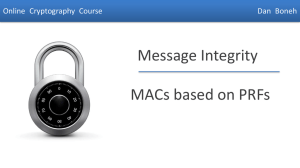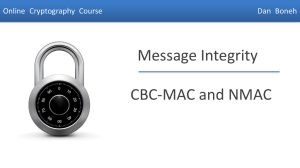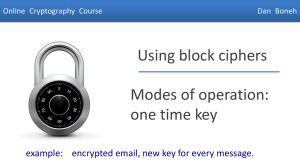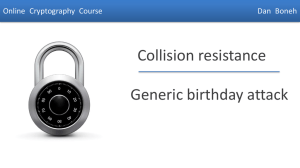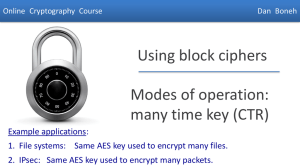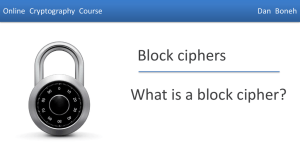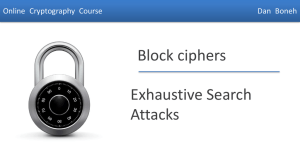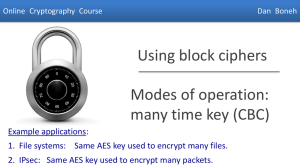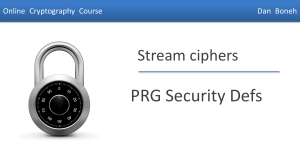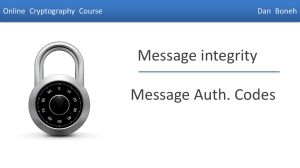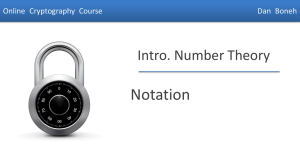Carter-Wegman MAC
advertisement
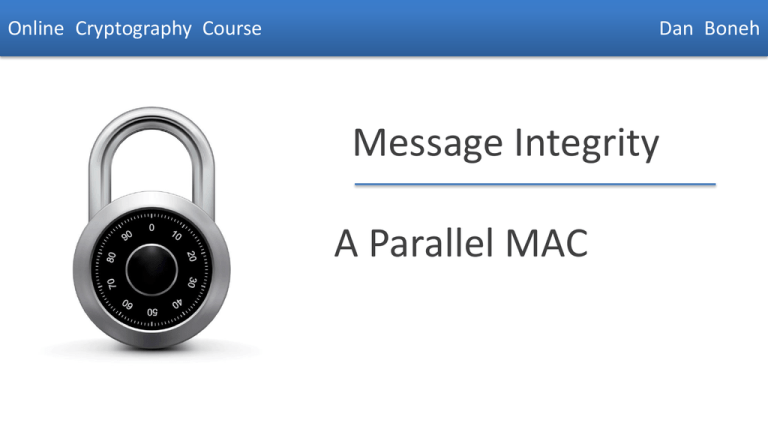
Online Cryptography Course
Dan Boneh
Message Integrity
A Parallel MAC
Dan Boneh
• ECBC and NMAC are sequential.
• Can we build a parallel MAC from a small PRF ??
Dan Boneh
Construction 3: PMAC – parallel MAC
P(k, i): an easy to compute function
key = (k, k1)
Padding similar
to CMAC
m[0]
P(k,0)
F(k1,)
m[1]
P(k,1)
m[2]
P(k,2)
F(k1,)
Let F: K × X ⟶ X be a PRF
Define new PRF FPMAC : K2 × X≤L ⟶ X
m[3]
P(k,3)
F(k1,)
F(k1,)
tag
Dan Boneh
PMAC: Analysis
PMAC Theorem: For any L>0,
If F is a secure PRF over (K,X,X) then
FPMAC is a secure PRF over (K, XL, X).
For every eff. q-query PRF adv. A attacking FPMAC
there exists an eff. PRF adversary B s.t.:
AdvPRF[A, FPMAC] AdvPRF[B, F] + 2 q2 L2 / |X|
PMAC is secure as long as qL << |X|1/2
Dan Boneh
PMAC is incremental
Suppose F is a PRP.
m[0]
P(k,0)
When m[1] ⟶ m’[1]
can we quickly update tag?
F(k1,)
m[1]
P(k,1)
m[3]
P(k,2)
F(k1,)
m[4]
P(k,3)
F(k1,)
F(k1,)
tag
no, it can’t be done
do F-1(k1,tag) ⨁ F(k1, m’[1] ⨁ P(k,1))
do F-1(k1,tag) ⨁ F(k1, m[1] ⨁ P(k,1)) ⨁ F(k1, m’[1] ⨁ P(k,1))
do tag ⨁ F(k1, m[1] ⨁ P(k,1)) ⨁ F(k1, m’[1] ⨁ P(k,1))
Then apply F(k1, ⋅)
One time MAC
(analog of one time pad)
• For a MAC I=(S,V) and adv. A define a MAC game as:
Chal.
kK
m1 M
Adv.
t1 S(k,m1)
(m,t)
b
b=1 if V(k,m,t) = `yes’ and (m,t) ≠ (m1,t1)
b=0 otherwise
Def: I=(S,V) is a secure MAC if for all “efficient” A:
AdvMAC[A,I] = Pr[Chal. outputs 1]
is “negligible.”
Dan Boneh
One-time MAC: an example
Can be secure against all adversaries and faster than PRF-based MACs
Let q be a large prime (e.g. q = 2128+51 )
key = (k, a) ∈ {1,…,q}2
(two random ints. in [1,q] )
msg = ( m[1], …, m[L] ) where each block is 128 bit int.
S( key, msg ) = Pmsg(k) + a
where Pmsg(x) = m[L]xL + … + m[1]x
(mod q)
is a poly. of deg L.
Fact: given S( key, msg1 ) adv. has no info about S( key, msg2 )
Dan Boneh
One-time MAC ⇒ Many-time MAC
Let (S,V) be a secure one-time MAC over (KI,M, {0,1}n ) .
Let F: KF × {0,1}n ⟶ {0,1}n be a secure PRF.
slow but
short inp
fast
long inp
Carter-Wegman MAC: CW( (k1,k2), m) = (r, F(k1,r) ⨁ S(k2,m) )
for random r ⟵ {0,1}n .
Thm: If (S,V) is a secure one-time MAC and F a secure PRF
then CW is a secure MAC outputting tags in {0,1}2n .
Dan Boneh
CW( (k1,k2), m) = (r, F(k1,r) ⨁ S(k2,m) )
How would you verify a CW tag (r, t) on message m ?
Recall that V(k2,m,.) is the verification alg. for the one time MAC.
Run V( k2, m, F(k1, t) ⨁r) )
Run V( k2, m, r )
Run V( k2, m, t )
Run V( k2, m, F(k1, r) ⨁ t) )
Construction 4: HMAC (Hash-MAC)
Most widely used MAC on the Internet.
… but, we first we need to discuss hash function.
Dan Boneh
Further reading
• J. Black, P. Rogaway: CBC MACs for Arbitrary-Length Messages: The ThreeKey Constructions. J. Cryptology 18(2): 111-131 (2005)
• K. Pietrzak: A Tight Bound for EMAC. ICALP (2) 2006: 168-179
• J. Black, P. Rogaway: A Block-Cipher Mode of Operation for Parallelizable
Message Authentication. EUROCRYPT 2002: 384-397
• M. Bellare: New Proofs for NMAC and HMAC: Security Without CollisionResistance. CRYPTO 2006: 602-619
• Y. Dodis, K. Pietrzak, P. Puniya: A New Mode of Operation for Block Ciphers
and Length-Preserving MACs. EUROCRYPT 2008: 198-219
Dan Boneh
End of Segment
Dan Boneh
